The London & North Western Railway’s (LNWR) Widnes Deviation had its origins in the take-over by the LNWR of the St Helens Canal & Railway Company (SHC&RC) on 1 September 1864. The LNWR had been keen to absorb the SHC&RC as it had strategic lines that carried lucrative flows of goods, in particular coal. However the LNWR inherited a situation at Widnes that was not ideal with regard to the easy movement of traffic. Effectively, two lines crossed on the level, and there were connecting spurs leading from one to the other. The lines were the original St Helens & Runcorn Gap Railway, which had opened between St Helens and Widnes on 21 February 1833, and the line between Garston and Warrington which had opened in two stages: between Widnes and Garston on 1 July 1852 and between Widnes and Warrington on 1 February 1853. The St Helens line ran from north to south and the Garston and Warrington line west to east. They crossed just north of Widnes Dock, which was the southern terminus for goods of the 1833 line.
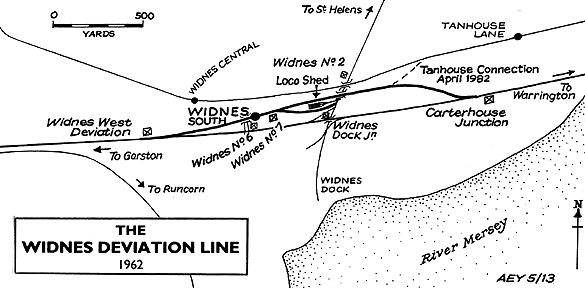 |
There was a connection that ran north from the St Helens line to west on the Garston line, and a connection that ran from east on the Warrington line to south on the St Helens line. The connections allowed trains to travel directly between St Helens and Garston and between Warrington and Widnes Dock. Close to the flat crossing, and connecting chords, there were numerous sidings and branches into factories by the mid 1850s. By the time that the LNWR took over there was a great deal of congestion.
The solution was to build a new line running west to east that would pass over the St Helens line but at the same time have a connection to it. This would allow through trains to avoid the flat crossing.
As part of its takeover of the SHC&RC the LNWR had pledged to spend £100,000 at Widnes carrying out improvements, and the money was duly set aside. On 5 July 1865 authorisation was given for the construction of the Widnes Deviation, and work started on its construction shortly after.
The Widnes Deviation opened to goods traffic on 1 November 1869. On 1 March 1870 a new Widnes station was opened on the line on the east side of Victoria Road and, from this date, all passenger services operated over it. The original lines saw only goods services, and the original Widnes station, which had been on the west side of the Waterloo Level Crossing, was closed.
The Deviation branched off from the original line at Widnes West Deviation Junction, 28 chains west of Victoria Road and to the east of De-Sotto Bridge. The line ran for 1½ miles, where it rejoined the original route to Warrington at Carterhouse Junction. From Widnes West Deviation Junction the Deviation line climbed steeply until it passed over Victoria Road. On the east side of Victoria Road was the 1870 Widnes station. Immediately east of Widnes station was the Widnes Junction. Controlled by Widnes No.7 signal box, this was originally located on the north side of the line at the east end of Widnes station’s up platform. In 1893 an LNWR Type 4 box replaced the original. It was located on the south side of the line at the east end of the down platform. A spur line turned south at the junction and dropped down at a gradient before turning towards the north, where it made a connection with the 1833 St Helens line at Ann Street. The spur allowed passenger services between Ditton Junction and St Helens Shaw Street to use the 1870 Widnes station.
The Deviation line continued eastwards from Widnes Junction, it crossed over Alforde Street on a bridge, continued for a short distance on an embankment adjacent to the Widnes locomotive shed, after which it ran onto a brick-built viaduct of seven arches. At the eastern end of the viaduct the Deviation crossed over the St Helens line on a bridge. The rest of the line was on an embankment, but there were three further bridges, two giving access to a works and one carrying the Cornubia Factory branch line under the Deviation. The line then dropped down to ground level at Carterhouse Junction. The junction at Carterhouse was controlled by a signal box (Carterhouse Junction) which was situated on the south side of the line to the east of the actual junction.
In the space between the main line and the St Helens line spur the LNWR built Widnes locomotive shed. Access to the shed for locomotives was from the St Helens line via Ann Street. To facilitate the movement of locomotives into and out of the shed from the Deviation there was a crossover line at the eastern end of Widnes station. The shed itself initially had three roads but it would later be extended to six roads.
In the 1870s the Deviation would have been used by passenger services running between Liverpool Lime Street and Manchester London Road, along with shorter workings on that route, and by the Ditton Junction and St Helens service. Through goods trains that outnumbered passenger services tenfold would also have used the Deviation at this time. The entire route between Garston and Skelton Junction became a major goods artery for the LNWR for east-west services.
In 1879 the Manchester, Sheffield & Lincolnshire Railway and the Midland Railway opened a joint line that became known as the Widnes Loop which ran parallel with the Deviation for much of its length, but to the north. The two lines were at their closest to the east of Ann Street but there was no connection between them.
Looking west at Widnes West Deviation Junction in 1968. The train to the right is coming off the deviation line and heading towards Ditton Junction.
Photo by Les Fifoot
On 1 January 1923 the Widnes Deviation became part of the London, Midland & Scottish Railway (LMS). The Deviation continued to perform the function for which it was built throughout the LMS years, but the locomotive sheds were given the new identification code of 8D. Traffic flows of note in the 1930s included banana trains that ran from Garston Dock eastwards, and coal from both the Lancashire and the Yorkshire Coalfields that ran to Garston Dock for export.
On 1 January 1948 the Deviation became part of the Nationalised British Railways (London Midland Region). On 16 June 1951 the Ditton Junction and St Helens passenger service was withdrawn but the service between Liverpool and Manchester continued to operate, although some trains started and ended their journeys at Ditton Junction or at Warrington Bank Quay. An express passenger service, the ‘York Mail’, which ran from Liverpool Lime Street to York, used the Deviation on Sunday nights, but did not stop at Widnes Station.
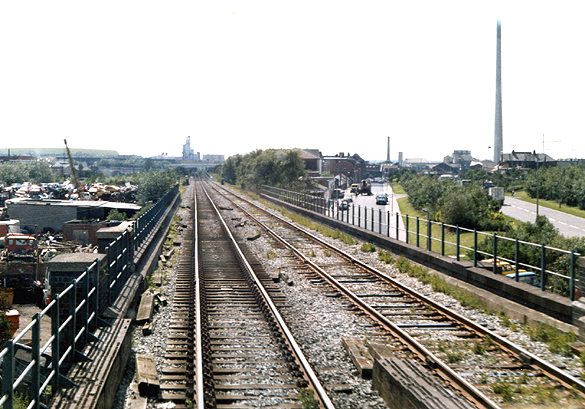 Looking west along the Widnes Deviation from the bridge that had spanned the St Helens and Runcorn Gap line on 22 June 1990.
Looking west along the Widnes Deviation from the bridge that had spanned the St Helens and Runcorn Gap line on 22 June 1990.
Photo by John Wilson |
On 10 September 1962 regular passenger services, except the ‘York Mail’, over the Deviation were withdrawn and Widnes South station closed. It was used though for Rugby League specials until 1965. In the early 1960s goods traffic began to decline. Widnes shed closed on 13 April 1964. The Widnes Loop, which ran parallel to the Deviation, closed completely in December 1964, except for the goods yard at Tanhouse Lane which was very close to the Deviation at its eastern end. In 1961 a connection had been put in from the St Helens line to Tanhouse Lane which was the first physical link between the former LNWR system and the Widnes Loop. There was still no direct connection from the Deviation to Tanhouse Yard at this time, but the idea to create one would be revisited two decades later.
On the 4 November 1968 the line from Ann Street to Widnes Dock, part of the original 1833 line, closed, and in March 1969 the original route between Carterhouse Junction and Widnes West Deviation closed as a through route, although lines were retained at both ends of the route at Hutchinson Street Yard to the west and between Carterhouse and the flat crossing to the east. These events meant that all traffic now ran over the Deviation and the connecting spur to the St Helens line.
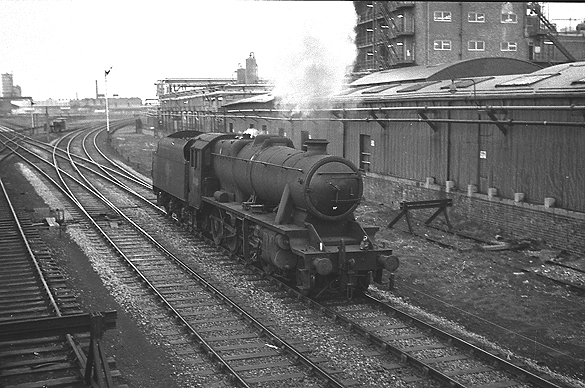 Carterhouse Junction looking west from the signal box in 1968. An ex LMS class 8F locomotive has just come off the deviation line and is heading towards Warrington. The deviation lines can be seen curving off to the right. Going to the left is the original route of the Garston and Warrington railway via Widnes Dock Junction.
Carterhouse Junction looking west from the signal box in 1968. An ex LMS class 8F locomotive has just come off the deviation line and is heading towards Warrington. The deviation lines can be seen curving off to the right. Going to the left is the original route of the Garston and Warrington railway via Widnes Dock Junction.
Photo by Les Fifoot |
On 1 November 1981 the St Helens line closed as a through route (between Farnworth & Bold and Clock Face). On 18 April 1982 a connection from the Deviation line to Tanhouse Yard opened. It was controlled by Carterhouse Junction signal box. The opening of the new connection allowed the line from Widnes No. 7 to Farnworth & Bold to close - It had already been lifted from Halton View bridge to Farnworth and Bold. Widnes Junction was taken out of use and Widnes No. 7 box was closed. The spur line was lifted in the following weeks, and the junction was removed.
Hutchinson Street Yard closed in 1988 which allowed Widnes West Deviation Junction signal box to be closed with effect from 19 December 1988. The connection to Tanhouse Yard saw its last traffic in 2000. Carterhouse Junction box was abolished on 3 December 2006 and demolished on 14 April 2007.
The Deviation line remained open to freight services in May 2013.
The 8D Association - Dedicated to promoting the history of South Lancashire and North Cheshire railways. Web Site
See also: Ann Street, Widnes and Widnes South stations.
See: Widnes Dock Junction, Widnes Locomotive Shed
and Widnes Goods (Huchinson Street).
To take a journey along the Widnes Deviation Railway in photographs click here |

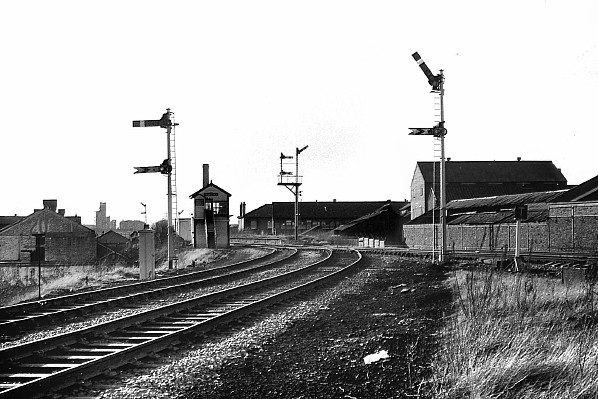

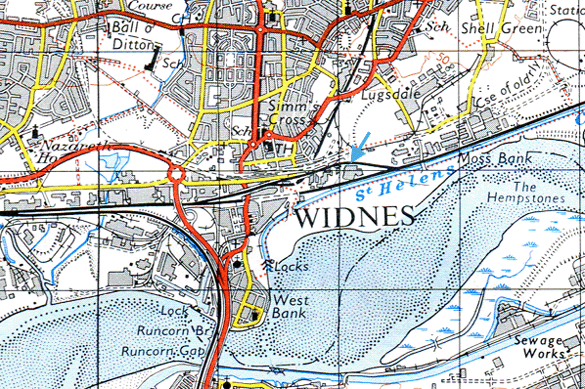
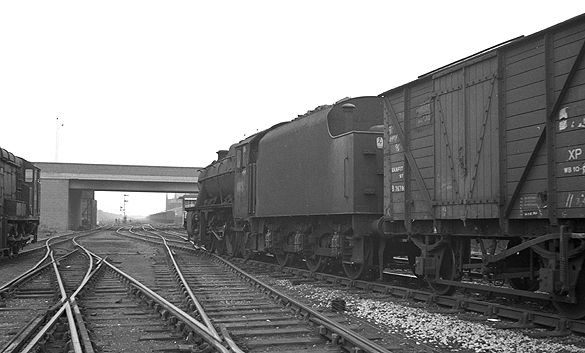



 Home Page
Home Page